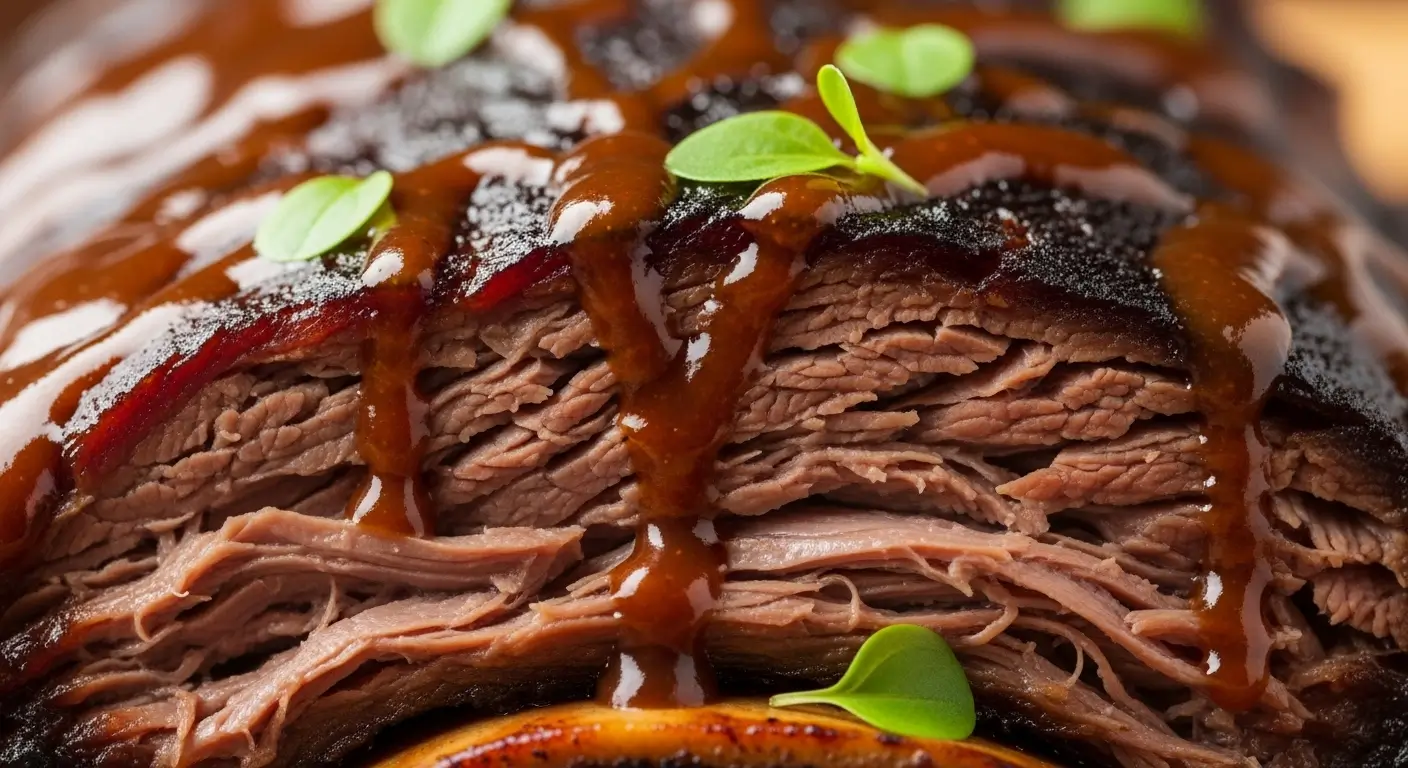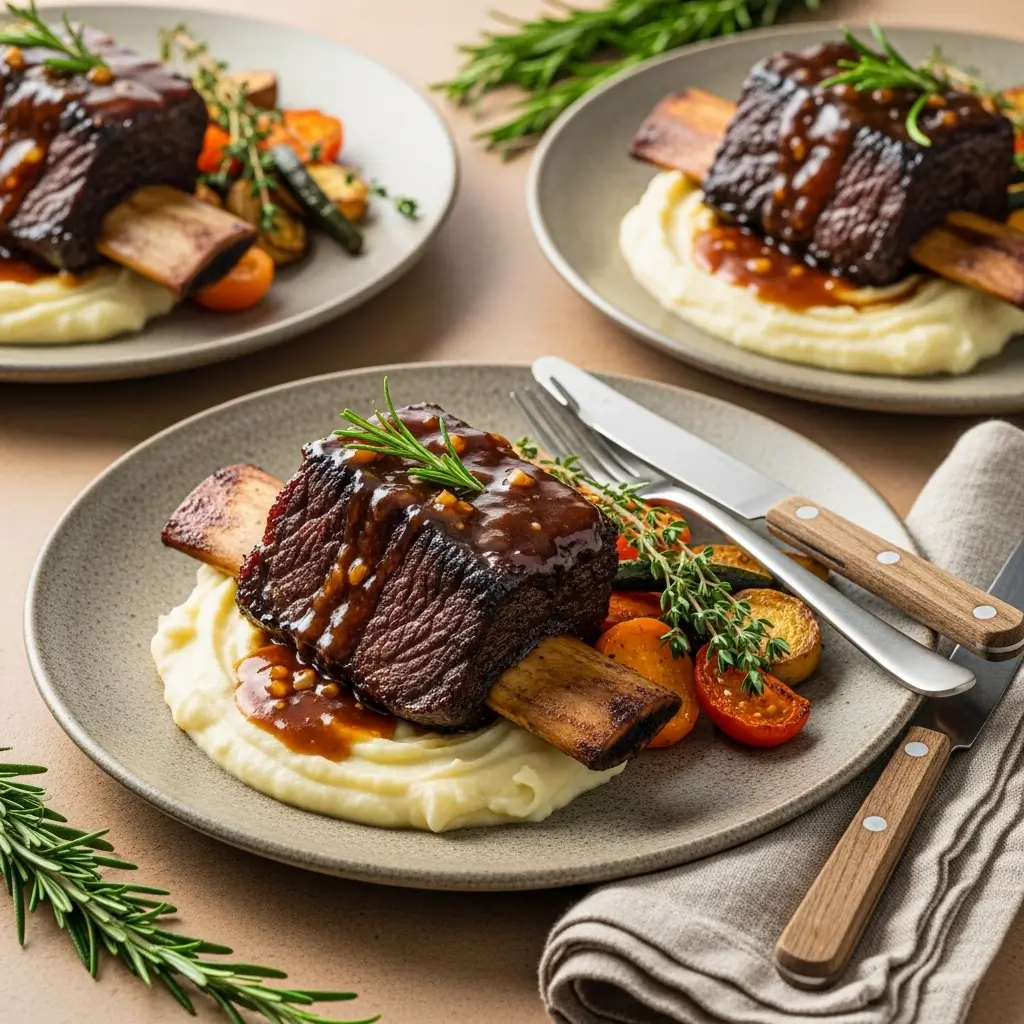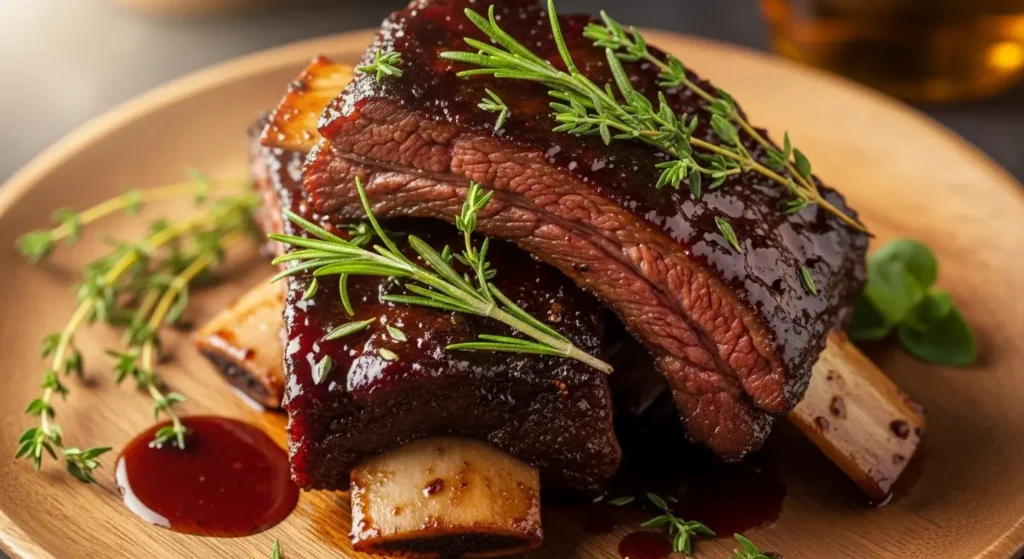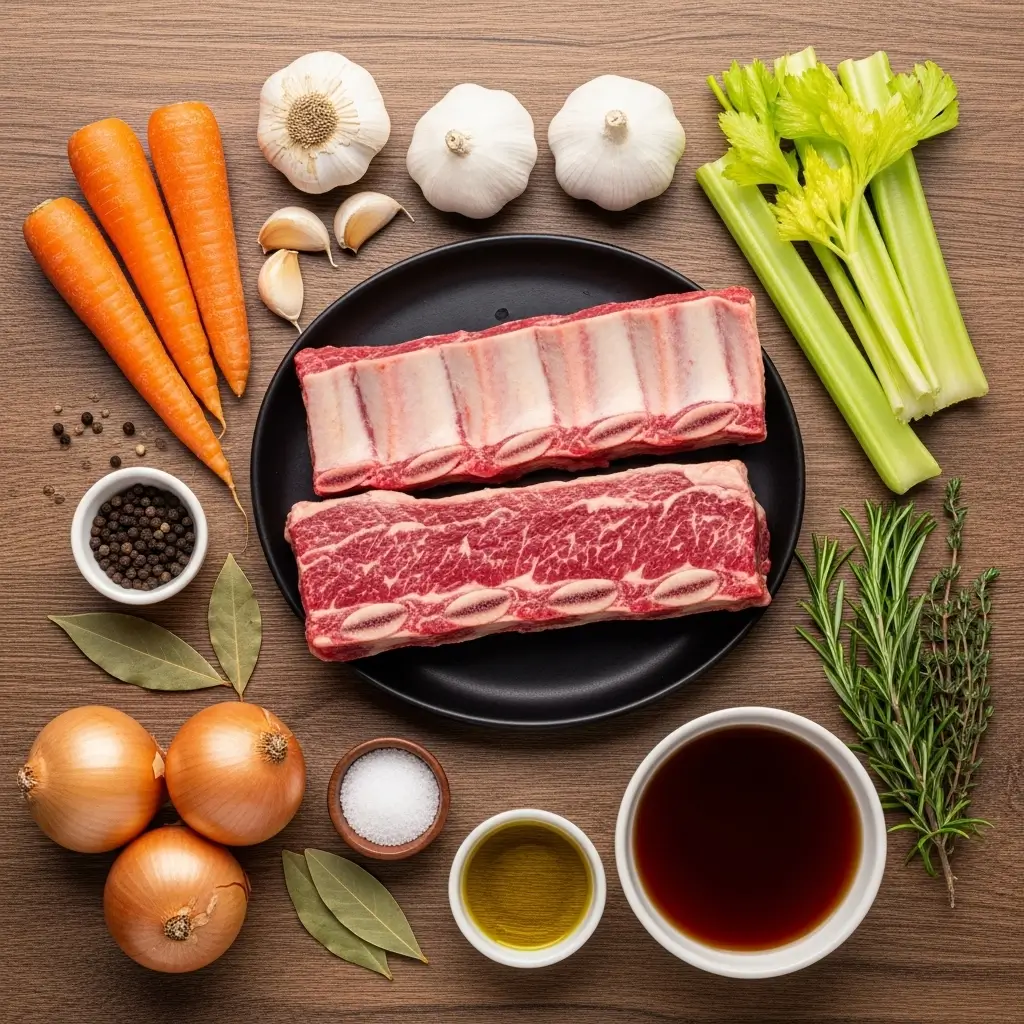Perfectly Tender Beef Short Ribs

There are few culinary experiences as deeply satisfying as a plate of perfectly cooked, fall-off-the-bone Beef Short Ribs. Imagine a chilly evening, the warmth of your kitchen filled with the savory, rich aroma of slow-simmering beef, and the promise of a meal that requires nothing more than a fork to enjoy. You’re not just cooking a piece of meat; you’re engaging in a culinary alchemy that transforms a tough cut into a velvety, succulent indulgence.
For the uninitiated, the idea of cooking Beef Short Ribs might seem intimidating. You may have tried them before and found them chewy or dry. But I’m here to tell you that with a few simple techniques embracing the patience of the “low and slow” philosophy you can consistently achieve that luxurious, melt-in-your-mouth tenderness every single time. This is your comprehensive guide to understanding, preparing, and mastering the incredible potential of Beef Short Ribs. Get ready to elevate your comfort food game and make some memories around the dinner table.
Decoding Beef Short Ribs: Cuts, Selection, and Prep
To truly master Beef Short Ribs, you must first understand what they are and where they come from. These flavorful cuts are taken from the chuck, plate, or rib section of the cow. The secret to their incredible richness lies in the high amount of collagen and fat, which, when cooked slowly, breaks down into gelatin, resulting in that unbelievably tender texture and deep, savory flavor you crave.

Understanding the Cuts: English vs. Flanken Style Beef Short Ribs
When you go to the butcher, you’ll typically encounter two main styles of Beef Short Ribs, and knowing the difference is crucial for your chosen recipe:
- English-Style Short Ribs: These are cut parallel to the bone, yielding thick, individual pieces of meat, each with a single, substantial bone. They are ideal for classic braising recipes, where you want a large, meaty presentation. These are often labeled simply as bone-in short ribs.
- Flanken-Style Short Ribs: These are cut across the bones, resulting in a thin strip of meat with three or four small pieces of bone in each piece. They are the traditional choice for grilling, particularly for Korean BBQ (Korean short ribs or Galbi), where the thinner cut allows for quick cooking and maximum surface area for the marinade.
| Cut Style | Description | Ideal Cooking Method | Best For |
| English-Style | Thick, meaty squares with one large bone | Braising, Slow Cooking, Smoking | Hearty stews, classic comfort food |
| Flanken-Style | Thin strips cut across the bone | Grilling, Searing, Quick Braise | Korean BBQ (Galbi), fajitas |
| Boneless | Meat cut completely off the bone | Any method, but can dry out faster | Convenience, shredding for tacos/sandwiches |
Preparation Secrets: Trimming, Seasoning, and Marinating
Before you apply any heat, proper preparation of your Beef Short Ribs is non-negotiable.
- Trimming: You may need to trim excess hard fat from the top layer. While fat is crucial for moisture, removing the very thick, hard pieces allows for better flavor penetration and prevents an overly greasy final product.
- Seasoning: A simple seasoning of coarse salt and freshly ground black pepper is always a great start. For a deeper crust (and superior flavor), a good dry rub with paprika, garlic powder, and brown sugar works wonders.
- Searing: Before the low and slow cook, searing the ribs on all sides in a hot Dutch oven or heavy-bottomed pot until deeply browned is the single most important step for developing rich, complex flavor. This Maillard reaction creates the depth that defines great Beef Short Ribs.

Mastering the ‘Low and Slow’ Method for Tender Results
The secret to fork-tender Beef Short Ribs is simple: time and temperature. You must cook them “low and slow” to give the collagen enough time to dissolve into luscious gelatin. This is what makes the meat so incredibly moist and easy to shred.
Braising and Slow Cooking: The Classic Way to Perfect Beef Short Ribs
Braising is the most beloved method for cooking Beef Short Ribs because it’s almost foolproof. After searing, you submerge the ribs about halfway in a flavorful liquid usually a mix of beef broth, red wine, and aromatics like carrots, onions, and garlic.
The process involves:
- Searing the seasoned Beef Short Ribs until a dark crust forms.
- Deglazing the pot with red wine to scrape up the flavorful brown bits (fond).
- Adding your braising liquid (broth, herbs) and bringing it to a simmer.
- Covering the pot tightly and placing it in an oven at a low temperature (around 325^\circ F / 160^\circ C) or into a slow cooker for 3 to 4 hours. The ribs are ready when they easily pull apart with a fork.
Alternative Methods: Smoking and Sous Vide for Modern Beef Short Ribs
While braising is classic, modern techniques offer incredible results for different flavor profiles.
- Smoked Short Ribs: If you love barbecue, smoked short ribs are a must-try. After applying a robust dry rub, the ribs are smoked at a low temperature (225^\circ F / 107^\circ C) for 5 to 7 hours until they develop a rich bark and a smoky flavor that rivals brisket.
- Sous Vide Short Ribs: This is the ultimate technique for guaranteed tenderness. Sealing the Beef Short Ribs in a vacuum bag and cooking them in a precisely temperature-controlled water bath for up to 48 hours breaks down the tough tissue perfectly. You finish them with a quick sear or a blast under the broiler for crust. The result is arguably the most tender Beef Short Ribs you will ever eat.
Three Global Short Rib Recipes You Need to Try
Beef Short Ribs are versatile and travel the world through diverse culinary traditions. Here are two essential short rib recipes to add to your repertoire.
Classic Red Wine Braised Beef Short Ribs Recipe
This is the quintessential method for tender Beef Short Ribs. The red wine and broth create a rich, savory sauce that is reduced and served over the finished meat, often alongside mashed potatoes or creamy polenta.

| Ingredient | Quantity | Notes |
| Beef Short Ribs (English-style) | 4 lbs | Pat dry and season generously. |
| Olive Oil | 2 tbsp | For searing the ribs. |
| Diced Onion | 1 medium | Adds aromatic depth. |
| Diced Carrots | 2 medium | Classic mirepoix vegetable. |
| Dry Red Wine (e.g., Cabernet) | 1 cup | Crucial for depth and deglazing. |
| Beef Broth | 4 cups | Use low-sodium to control salt. |
| Tomato Paste | 2 tbsp | Adds umami and richness. |
| Thyme & Bay Leaves | 3 sprigs / 2 leaves | Essential herbs for braising. |
Instructions Summary: Sear the Beef Short Ribs in a Dutch oven, remove them, sauté the vegetables, stir in tomato paste, deglaze with wine, add broth and herbs, return the ribs, cover, and bake at 325^\circ F (160^\circ C) for 3-4 hours.
Spicy Korean BBQ Beef Short Ribs (Galbi) Marinade
For a complete flavor departure, Flanken-style Beef Short Ribs are marinated and grilled quickly. The marinade tenderizes and imparts a perfect balance of sweet, savory, and spicy notes.
- The Marinade: Combine soy sauce, sesame oil, brown sugar, minced garlic, ginger, and a pureed Asian pear (a natural tenderizer) or kiwi.
- Marinating: Submerge the Flanken-style Beef Short Ribs completely and let them marinate for at least 6 hours, or ideally overnight, allowing the flavors to penetrate the thinly sliced meat.
- Grilling: Grill the marinated ribs over medium-high heat for only 2-3 minutes per side. The intense heat gives them a beautiful char and crisp edges.
This method gives you incredibly flavorful, quickly cooked Beef Short Ribs that are perfect for a summer BBQ.
Conclusion: Your Newfound Short Rib Confidence
You are now equipped with the knowledge to conquer the kitchen and create truly memorable meals with Beef Short Ribs. Whether you choose the comforting depth of a classic braise, the smoky complexity of the smoker, or the quick-grill excitement of Korean Galbi, the path to tender, luxurious beef is a journey well worth taking.
The key takeaway is simple: patience is your most important ingredient. Allow the low, slow heat to do its work, and you will be rewarded with a flavor and texture that will impress even the toughest critic. No more tough, chewy meat just perfect, melt-in-your-mouth Beef Short Ribs.
FAQ Section: Common Questions About Beef Short Ribs
Q: Why are my Beef Short Ribs tough after cooking?
A: The most common reason your Beef Short Ribs are tough is that you haven’t cooked them long enough. Toughness indicates that the collagen and connective tissues have not had sufficient time to break down into gelatin. You must continue cooking them either by braising or slow cooking until the meat is easily shredded with a fork. It often takes a full 3 to 4 hours, and sometimes even longer, depending on the size and thickness of your Beef Short Ribs. Don’t rely solely on time; rely on the tenderness test!
Q: Can I use boneless Beef Short Ribs instead of bone-in?
A: Yes, you absolutely can use boneless short ribs, but be aware that the bone adds significant flavor and moisture during the long cooking process. If using boneless, you may need to reduce the total cooking time slightly, as they can dry out faster without the protection of the bone. For maximum flavor, we still recommend bone-in Beef Short Ribs for braising, but boneless cuts work well for quick recipes or when you plan to shred the final product for tacos or sandwiches.
Q: What is the ideal internal temperature for finished Beef Short Ribs?
A: Unlike steak, which is judged by specific temperatures for doneness, Beef Short Ribs are done when the collagen has fully rendered, which is a process that occurs over time. While the meat is safe to eat when it hits an internal temperature of 160^\circ F (71^\circ C), it won’t be tender. For that signature, fall-apart texture, the ribs typically reach an internal temperature between 195^\circ F (90^\circ C) and 205^\circ F (96^\circ C). However, forget the thermometer; you’ll know your Beef Short Ribs are ready when you can effortlessly pull the meat from the bone.
Are you ready to try your hand at the magic of “low and slow” cooking? Try this today and share your favorite Beef Short Ribs success story or recipe variation in the comments below!
Perfectly Braised Beef Short Ribs
A comforting and rich recipe for melt-in-your-mouth beef short ribs, ideal for slow cooking.
Recipe Overview
| Preparation Time | PT30M |
| Cooking Time | PT4H |
| Total Time | PT4H30M |
| Type of Recipe | Main Dish |
| Cuisine | American, French, Comfort Food |
| Recipe Yield | 4 servings |
| Calories | 650 kcal |
Ingredients
| Quantity | Ingredient |
|---|---|
| 4 lbs | Beef Short Ribs (Bone-in, English Cut) |
| 2 tbsp | Olive Oil |
| 1 cup | Dry Red Wine (e.g., Cabernet Sauvignon) |
| 4 cups | Beef Broth |
| 1 large | Onion, chopped |
| 2 | Carrots, chopped |
| 2 cloves | Garlic, minced |
| 1 tbsp | Tomato Paste |
| 2 | Bay Leaves |
| Salt & Pepper | To taste |
Instructions
- Preheat oven to 325°F (160°C). Season the short ribs generously with salt and pepper.
- Sear the short ribs in olive oil in a Dutch oven on all sides until deeply browned. Remove and set aside.
- Add onion and carrots to the pot and sauté until softened (about 5 minutes). Stir in garlic and tomato paste and cook for 1 minute.
- Deglaze the pot with red wine, scraping up the browned bits from the bottom. Reduce by half.
- Return the ribs to the pot. Add beef broth and bay leaves until ribs are about two-thirds submerged.
- Cover the Dutch oven tightly and braise in the preheated oven for 3.5 to 4 hours, or until the meat is fork-tender.
- Skim excess fat from the sauce before serving.
Editorial Review
Overall Rating:
Pros:
- Achieves incredible, melt-in-your-mouth tenderness.
- The dark, rich sauce is perfect for pairing with mashed potatoes or polenta.
- Excellent for cold weather and entertaining.
Cons:
- Requires a long braising time (4+ hours).
- High initial fat content needs proper trimming/skimming.
Customer Ratings & Comments
Average Rating: (Based on 54 reviews)

